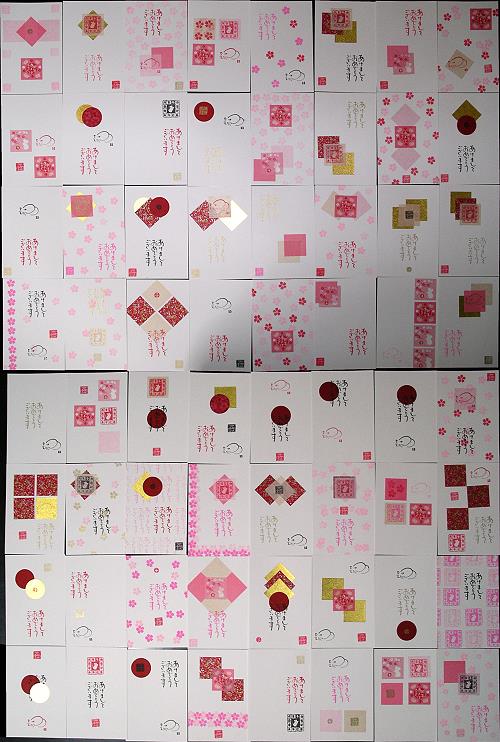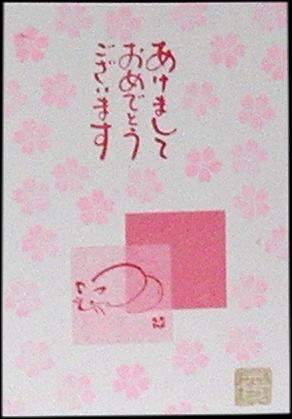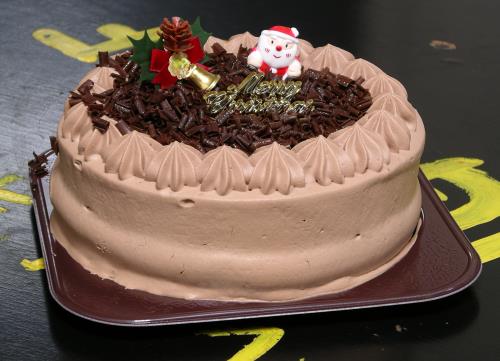| |
Nengajou are traditional New Year's postcards in Japan. They are sent to arrive on or after New Year's Day. It's even considered rather awkward if they arrive early! Late is okay, but it's really best for them to arrive on January 1. For this reason, the post office has a special system set up. When correctly marked as a nengajou, cards are set aside for special handling. Then on New Year's Day, they mobilize thousands of extra employees to deliver all the cards on the same morning. There's a long tradition of handmade cards. In the month before New Year's you can buy blank postcards, which you can decorate by hand with stickers and rubber stamps. You can also use a stencil machine, print them from your computer, or simply draw them by hand. Recently, there are also services in camera shops and on the internet to order your own custom designs. People without such creative inclinations can buy them with pre-printed designs. This year, instead of Christmas cards, we decided to send out nengajou. We used stickers and rubber stamps to decorate ours. A nice feature of making them by hand is that it's easy to make each one unique.  And here's a closeup of one card.  2008 is the "Year of the Rat" on the Asian calendar. There doesn't seem to really be much distinction between mice and rats here (the Japanese word for mouse is actually "small rat"), so it's really treated as the Year of the Mouse. That's why there are all the cute little mice on our nengajou.
[ 4 comments ] permalink
Thursday, December 27, 2007, 7:29 PM GeneralPosted by stefanie One of the biggest frustrations of living in a foreign, non-English-speaking country is learning the language. Immersion is a great thing, especially combined with formal lessons ― on a daily basis, you have to use the language for communication, so you're forced to practice what you've learned. Unfortunately, there's no magic way to go from beginner to fluent in no time flat. In our experience, this leads to an annoying alternation between having a relatively easy conversation and hanging up the phone going "I have no idea what just happened." We're now in Week 2 of the Missing Car Key Saga. It's mostly resolved, though getting there has involved all ranges of the communication spectrum. I made a police report with little difficulty. Between the key guy and our car guy, we've managed to get keys and send the car to the dealership in Morioka for security setup. I was able to work out details of the shipping, return, and payment of the car with no problem. I was feeling very pleased about this; I've been studying Japanese for a little less than a year, I've lived here for six months, and now I can conduct some business. It's much easier than when I had to get my glasses repaired about a week after I arrived in Kitakami ― it might take repetition and talking slow, but no one has to pull up Google Translation to deal with me. Not necessarily, anyway. Yesterday, the police station called about the key. What they wanted to tell me or ask me about the key, I can't say. Almost from the beginning of the conversation, it was clear that we were getting nowhere. Repeated requests to say something again failed to result in comprehension. The policewoman spoke at full speed the whole time; I couldn't remember how to ask her to slow down. After I got off the phone, I felt deflated, having gone from competent to clueless in three short hours. We've discovered that in situations where we're faced with speaking only Japanese for a prolonged period, there comes a moment when we hit a wall, and we simply can't process any more ― it all just washes by us. That whole conversation took place at the wall. We know that the longer we're here and the more Japanese we learn, the times when we can't communicate will lessen. In the meantime, we persevere. Ganbarimasu!
Our first Christmas in Japan is over, save for the sort of "second Christmas" we get by virtue of having family in the U.S. We can call people pretty much any time between the morning of the 25th and the morning of the 26th, and it's Christmas for someone. It's really rather nice. Christmas isn't really a big deal in Japan. It's not a national holiday, so we got mail delivery today, and most people worked. Also, turkey is essentially nonexistent here, so many families celebrate with KFC. We couldn't make ourselves get KFC, opting for an all-American dinner of steak, mashed potatoes, and grilled asparagus. Matthew hasn't had mashed potatoes in at least nine months, so he was pretty excited about them. We did, however, follow tradition and get a Christmas cake.  As we've mentioned before, the Japanese Christmas cake is traditionally sponge cake with whipped cream and strawberries. We ordered one with chocolate whipped cream, which turned out to have bits of pineapple and peaches in the middle. It came with a box of strawberries for garnish.  It was pretty tasty, too. Merry Christmas, everyone!
On Toji, the winter solstice, the Japanese greet the end of darkening days with traditions aimed at improving health. Grocery stores are filled with yuzu, a small yellow citrus fruit with a taste and aroma similar to grapefruit. It is traditional to toss a few yuzu into the ofuro, allowing you to relax in a hot bath surrounded by the fragrant oils. Similarly, eating kabocha (Japanese pumpkin) on the solstice is believed to prevent colds in the coming year. We celebrated Toji by mixing traditions ― and cocktails. An acquaintance had gifted us with a kabocha some time ago, so we simmered it for dinner with some fresh ginger (given our track record, we're all about combining as many cold-prevention ingredients and traditions as possible). We filled our ofuro with sliced yuzu for a refreshing end to a difficult week. And, we shook yuzu juice with gin and Cointreau in a celebratory cocktail, raising our glasses to the return of light and the prospect of good health in the coming year.
Thursday, December 20, 2007, 2:51 PM GeneralPosted by matthew How big do snowflakes get? I mean a single six-pointed lacy bit of ice, drifting down from the sky. When you see big snowflakes coming down, they're not just a single snowflake: each fluffy white "flake" is really a clump of small snowflakes and snowflake parts.
My morning walk with the dogs started with overcast skies, but no precipitation. A few minutes into it, a big snowflake fell near Moki. It seemed a little odd, as it was the only one. I wondered if it had fallen from a tree or something, but there was nothing near. Then a few seconds later, I saw another one. Gradually, more of them began to fall, but it was still an interesting combination of large but very sparse snowflakes.
Then, one landed on my coat where I could get a good look at it. It was one large, intact, snowflake, about half an inch across. A couple of smaller snowflakes (maybe an eighth of an inch) had stuck to it, but didn't hide or damage its delicate structure. It's one of the most amazing things I've ever seen. I spent the rest of the walk catching snowflakes to try to find another one — but all I could get were clumps of small snowflakes and snowflake parts jumbled together.
[ 4 comments ] permalink
Losing My Mind (Among Other Things)
Thursday, December 20, 2007, 1:22 AM GeneralPosted by stefanie It's been a tough couple of weeks for relatively valuable items here at Let's Sharing HQ. Between last week's lost wallet and yesterday's lost car key, we've spent a goodly amount of time retracing our steps (fortunately, Kitakami isn't that big) and revisiting establishments in search of our missing items. And I've become quite proficient at filing lost item reports in Japanese, which is the bright side here. Isn't necessity the mother of language learning? I think I heard that somewhere.
Today's chapter in the lost key saga found me at a small key shop located inside a kitchen supply store, run by an old, weathered Tohoku-jin. Our conversation required patience on both sides: for him, because I need a fair amount of repetition, slow talking, and cognition time before I can understand something, and for me because he spoke with a thick accent and the low, mumbly speech frequently used by older northern Japanese men. And he had a boatload of customers coming in and out, including another guy with a thick accent and mumbly speech. They had a long conversation about something while I waited, drooling over the Japanese knives; for all I know, they were talking about the Amerika-jin with negligible language skills needing a hard-to-make key for a German car.
At any rate, we weren't able to work out a keymaking arrangement today, so he asked me to come back tomorrow. I can't make it, so I offered up Matthew as a substitute with the assurance that he speaks better Japanese than I do. In retrospect, I think I actually told him someone's dad would be coming. Oops.
[ 6 comments ] permalink
We finally had our big kerosene heater installed last week, much to Christina's (and our) relief. It's kind of a shame that a Tohoku winter vacation based out of Pension Let's Sharing will no longer have a full day of seeing your breath inside as an attraction. Then again, it's nice to be able to feel my hands during the day. Here's our new best friend:  You can't read the placard on the front, but it is, appropriately, an "Excellent" heater.
Friday, December 7, 2007, 3:33 AM GeneralPosted by stefanie For all the complaining we've been doing about the cold (and now that our friend Christina has been visiting for almost a week, there's been half again as much commentary), it does have its benefits. For example, visiting onsen is much, much more awesome in the snow. You're wicked cold when you first enter the building, and then again when you change to wash, but sitting in the bath heats you to the core. Then you're warmed through, and ready to go out in the snow again.
Even better is sitting in a rotenburo, or outdoor bath. The water is nice and hot, the air refreshing and cold. Falling snow sublimates on the surface of the bath, melting a little more slowly on your skin. If you're lucky, you can see a beautiful, white mountain from your seat, maybe crowned with the glittering lights of the traditional Japanese inn (ryokan). The cold is an integral part of the experience ― so much that you don't mind the slushy roads that take you there, then lead you home.
[ 8 comments ] permalink
Friday, November 30, 2007, 12:39 AM GeneralPosted by stefanie Right before I left Washington, I paid one last visit to my fantastic stylist. My hair never looked so good until I started going to Vera (although I had much better stories about the abusive French stylist I saw prior to her), so it was with much sadness and apprehension that I got my last trim. After all, I was leaving her care for a nation composed almost entirely of people with thick, shiny, stick-straight hair. What was a curly-haired girl going to do? Two years is a little long to go without a haircut, even for me (which was a point of contention with the abusive French stylist).
Perms are very popular in Japan, so someone suggested that I find a stylist who cuts permed hair. Fortunately, I was able to find something better. As it turns out, my Japanese teacher's stylist is a Japanese woman with naturally curly hair, which is pretty unusual. Clearly, she was the stylist for me. So, I pushed past the nerves, scheduled an appointment over the phone (Woo-hoo! I made an appointment over the phone!), and got my first haircut in Japan today.
I highly recommend the Japanese haircut. There's lots of head massage action involved, and very close attention to the look of the cut, down to the individual hairs. Also, there's lots of head massage action. It looks and moves like a good cut, though I won't know for sure until I try to do something with it tomorrow. Yay for the J-haircut!
[ 2 comments ] permalink
Saturday, November 24, 2007, 1:05 PM GeneralPosted by stefanie Based on the earlier-than-normal snowfall, it seems that we're in for a long, cold Tohoku winter. At home, we're living under the kotatsu, small space heater at our sides. We wear long underwear to bed and burrow deep within our doubled duck-down kakebuton. The dogs seem to appreciate the heated electric carpet we obtained from a departing expatriate. That's how you know it's really honking cold: the Akita inu, who should be adequately coated for the winter, are digging on the heated carpet. We know it's cold because we can see our breath inside the house when we wake up in the mornings. Yeeks.
The change from Fahrenheit to Celsius exacerbates the feeling of coldness. When I started the car yesterday, the temperature gauge flashed at me: 1.0C, 1.0C, 1.0C. Later, it flashed at me again: 0.5C, 0.5C, 0.5C. These are temperatures slightly above 32 degrees Fahrenheit, which we've clearly experienced, but seeing them expressed in single or fractional digits makes them seem significantly colder. Soon, we'll be in negative temperatures; I wonder if the car will find those flashworthy.
Still, we and other locals continue to travel on our bikes. Yesterday, I saw a guy riding home in the snow, carrying three big daikon in the basket on the front of his bike. There's certainly a different kind of "normal" here than we're used to...
[ 4 comments ] permalink
Back Next
|
|







 Calendar
Calendar




